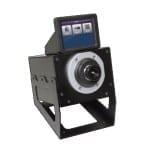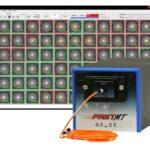Let’s get down to why we spend a lot of time working with benchtop microscopes. Simply put, faulty optical connections are the primary cause of network failures and to rectify that, high-performance fiber inspection is critical.
Cleanliness can describe both permanent defects (example: cracks) and loose contamination defects (example: dirt, dust, cleaning solvent residues).
Inspection is critical for telecom and datacom applications and some would argue that the most critical place is at the production facility. Industry standards for end-face cleanliness (for example IEC-61300-3-35) have led many manufacturers to prove their compliance with certification records.

As referenced in our Ensuring Clean Fiber Connections blog:
Cisco had this information under their Inspection and Cleaning are Critical section that illustrates the delicacy of the situation: “A 1-micrometer dust particle on a single-mode core can block up to 1% of the light (a 0.05dB loss). A 9-micrometer speck is still too small to see without a microscope, but it can completely block the fiber core. These contaminants can be more difficult to remove than dust particles. By comparison, a typical human hair is 50 to 75 micrometers in diameter, as much as eight times larger. So, even though dust might not be visible, it is still present in the air and can deposit onto the connector.”
Optimizing Workflow Efficiency is one of our customers’ greatest needs when choosing another piece of equipment on the benchtop. On the production floor, time is money, so we have put together a list of the greatest inspection needs when focused on helping protect the bottom line.
This list of “necessaries” include:
- Auto-focus. Built-in Autofocus capability eliminates manual time increase spent getting the image in optimized focus.
- Automation workflow options. In addition to Auto-Focus, Auto-Test, Auto File Naming, and Auto-Save after Test are crucial for keeping times down.
- Single report for multiple tests. The ability to create groups of tests that can be displayed together in one consolidated test report increases efficiency.
- Single test for both inspection and power measurement. The ability to create a certification report for both connector end faces and optical loss is crucial for industry standards.
Remember that contamination is the #1 cause of troubleshooting in optical networks and ensuring the cleanliness of fiber optic connectivity is essential whenever fiber is handled.
We have found and added to our product offerings, great solutions for both single system (FVAi) and MT fiber connector (FastMT) needs.

Single Fiber System
The FVAi digital bench-top microscope as an ideal inspection solution for fiber connector production. It gives users a single system that is scalable to optimize throughput at any stage of the production process. With onboard capabilities that meet our necessity list, it is an option for optimizing workflow efficiency on the production floor.
The FVAi Benchtop Microscope has been added here on our website.
Features
- All-in-one automated system for fiber end face testing and certification
- Autofocus and auto-center
- Locates and counts defects and scratches
- Automated pass/fail analysis
- Adjustable, scalable automation settings from all-manual to all-automated
- Onboard result storage
- Integrated 3.5 in color touch screen
- Simple graphical menu-driven interface
- Includes both VGA and USB outputs for external monitor connections
- 2 USB ports for connecting external devices such as P5000i, MP-60
Benefits
- Optimize throughput at any stage of production with scalable functionality
- Eliminate subjectivity from inspection with a fully automated system for fiber inspection
- Save valuable benchtop space with compact size
- Inspect, test, and store results on a single device — no external PC or monitor required
- Significantly reduce total inspection time by removing the need to focus the fiber manually
- The document that your product is compliant to end-face quality standards such as IEC-61300-3-35

MT Fiber System
FastMT automatically displays from 8 up to 72 individual fiber ends in a simultaneous image of all-fiber regions of MT fiber connectors. Every fiber is automatically detected and displayed without scrolling or refocusing providing a single maximized view recording the inspection and verification process.
Features
- Automated Pass/Fail
- Display Fibers Simultaneously
- Flexible Criteria
- Archive Data & Images
- Adapted for: MT-UPC & APC, MPO-UPC & APC, SC, LC, and PRIZM MT connectors
- MT-12 on FastMT-200 tests in approximately 12 seconds.
- MT-72 on FastMT-200 fully processes in approximately 35 seconds.
Benefits
- Labor Cost Reduction
- Increase Throughput >10x
- Reduce Supply Chain Friction
- Documented Results for QA
Continue to send us your technical questions at AskFOC: AskFOC@focenter.com and we will respond ASAP.
We continue to post technical solution content through our blogs: focenter.com/blog/ and push them out through Twitter.



